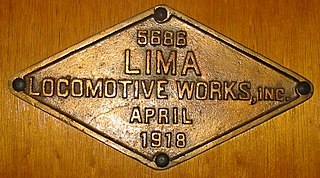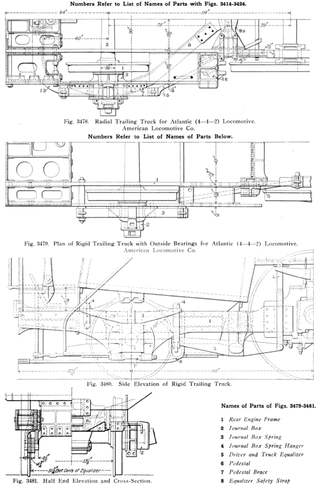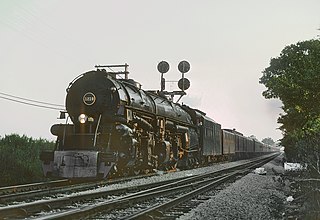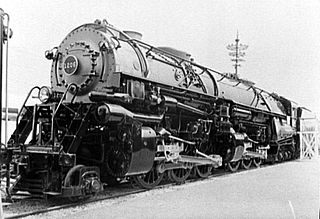
A 2-8-8-4 steam locomotive, under the Whyte notation, has two leading wheels, two sets of eight driving wheels, and a four-wheel trailing truck. The type was generally named the Yellowstone, a name given it by the first owner, the Northern Pacific Railway, whose lines ran near Yellowstone National Park. Seventy-two Yellowstone-type locomotives were built for four U.S. railroads.

A 4-8-8-4 in the Whyte notation for the classification of steam locomotives by wheel arrangement, is a locomotive with a four-wheel leading truck, two sets of eight driving wheels, and a four-wheel trailing truck. Only one model of locomotives has ever used this wheel configuration, and that is commonly known as "Union Pacific Big Boys" after the railroad that operated them.

Lima Locomotive Works was an American firm that manufactured railroad locomotives from the 1870s through the 1950s. The company took the most distinctive part of its name from its main shop's location in Lima, Ohio. The shops were located between the Erie Railroad main line, the Baltimore & Ohio's Cincinnati-Toledo main line and the Nickel Plate Road main line and shops.

Under the Whyte notation, a 2-8-4 is a steam locomotive that has two unpowered leading wheels, followed by eight coupled and powered driving wheels, and four trailing wheels. This locomotive type is most often referred to as a Berkshire, though the Chesapeake and Ohio Railway used the name Kanawha for their 2-8-4s. In Europe, this wheel arrangement was mostly seen in mainline passenger express locomotives and, in certain countries, in tank locomotives.
A 2-8-8-2, in the Whyte notation for describing steam locomotive wheel arrangements, is an articulated locomotive with a two-wheel leading truck, two sets of eight driving wheels, and a two-wheel trailing truck. The equivalent UIC classification is, refined to Mallet locomotives, (1'D)D1'. These locomotives usually employ the Mallet principles of articulation—with the rear engine rigidly attached to the boiler and the front engine free to rotate—and compounding. The 2-8-8-2 was a design largely limited to American locomotive builders. The last 2-8-8-2 was retired in 1962 from the N&W's roster, two years past the ending of steam though steam was still used on steel mill lines and other railroads until 1983.

The Roanoke Shops is a railroad workshop and maintenance facility in Roanoke, Virginia. Between 1884 and 1953, the shops produced 447 steam locomotives, all for the Norfolk and Western Railway (N&W). The Roanoke Shops built the N&W's famous Big Three class steam locomotives; the 4-8-4 class J, the 2-6-6-4 class A, and the 2-8-8-2 class Y6. In late 1953, the Shops built their final steam locomotive, making it last standard gauge steam locomotive built for revenue service in the United States. In 2020, N&W's successor, Norfolk Southern abandoned the Shops and Genesis Rail Services acquired the property in July 2023.

On a steam locomotive, a trailing wheel or trailing axle is generally an unpowered wheel or axle (wheelset) located behind the driving wheels. The axle of the trailing wheels is usually located in a trailing truck. On some large locomotives, a booster engine was mounted on the trailing truck to provide extra tractive effort when starting a heavy train and at low speeds on gradients.

Under the Whyte notation for the classification of steam locomotives, a 4-8-8-2 is a locomotive with four leading wheels, two sets of eight driving wheels, and a two-wheel trailing truck.

In the Whyte notation for classifying steam locomotives by wheel arrangement, a 4-6-6-4 is a railroad steam locomotive that has four leading wheels followed by two sets of six coupled driving wheels and four trailing wheels. 4-6-6-4's are commonly known as Challengers.

The 2-6-6-6 is an articulated locomotive type with two leading wheels, two sets of six driving wheels and six trailing wheels. Only two classes of the 2-6-6-6 type were built. One was the "Allegheny" class, built by the Lima Locomotive Works. The name comes from the locomotive's first service with the Chesapeake and Ohio Railway beginning in 1941, where it was used to haul loaded coal trains over the Allegheny Mountains. The other was the "Blue Ridge" class for the Virginian Railway. These were some of the most powerful reciprocating steam locomotives ever built, at 7,500 hp, and one of the heaviest at 386 tons for the locomotive itself plus 215 tons for the loaded tender.
Under the Whyte notation for the classification of steam locomotives, a 2-8-8-8-4 has two leading wheels, three sets of eight driving wheels, and four trailing wheels.

The Royal Bavarian State Railways' sole class S 2/6 steam locomotive was built in 1906 by the firm of Maffei in Munich, Germany. It was of 4-4-4 wheel arrangement in the Whyte notation, or 2'B2' h4v in the UIC classification scheme, and was a 4-cylinder, von Borries, balanced compound locomotive. It was initially assigned No. 3201.

Southern Railway 4501 is a preserved Ms class 2-8-2 "Mikado" type steam locomotive built in October 1911 by the Baldwin Locomotive Works in Philadelphia, Pennsylvania, as the first of its wheel arrangement type for the Southern Railway (SOU). In 1948, the locomotive was retired from the Southern Railway in favor of dieselization and was subsequently sold to the shortline Kentucky and Tennessee Railway (K&T) in Stearns, Kentucky, to haul coal trains.

The Norfolk and Western J class was a class of 14 4-8-4 "Northern" streamlined steam locomotives built by the Norfolk and Western Railway (N&W) at its Roanoke Shops in Roanoke, Virginia, between 1941 and 1950. The most powerful 4-8-4 locomotives ever produced, the J class were part of the N&W's "Big Three" that represented the pinnacle of steam technology.

Norfolk and Western 1218 is a preserved four-cylinder simple articulated 2-6-6-4 steam locomotive, built in June 1943 by the Norfolk and Western's (N&W) Roanoke Shops in Roanoke, Virginia as part of the N&W's class "A" fleet of fast freight locomotives. It was retired from regular revenue service in July 1959, and was later restored by Norfolk Southern for excursion service for their steam program, pulling excursions throughout the eastern United States from 1987 to 1991. It is currently on display at the Virginia Museum of Transportation in Roanoke, Virginia.

The Norfolk and Western M, M1 and M2 Classes were a series of 4-8-0 steam locomotives owned and operated by the Norfolk and Western Railway (N&W). The M Classes were primarily assigned to pull the N&W's mainline freight trains, but following the introduction of the railway's Y Class 2-8-8-2's, the M Classes were reassigned to short line freight service.

Norfolk and Western 611, also known as the "Spirit of Roanoke" and the "Queen of Steam", is the only surviving example of Norfolk and Western's (N&W) class J 4-8-4 type "Northern" streamlined steam locomotives. Built in May 1950 at N&W's Roanoke Shops in Roanoke, Virginia, it was one of the last mainline passenger steam locomotives built in the United States and represents one of the pinnacles of American steam locomotive technology.

Chesapeake and Ohio Railway 2716 is a class "K-4" 2-8-4 "Kanawha" (Berkshire) type steam locomotive built in 1943 by the American Locomotive Company (ALCO) for the Chesapeake and Ohio Railway (C&O). While most railroads referred to these 2-8-4 type locomotives as Berkshires, the C&O referred to them as Kanawhas after the Kanawha River, which flows through West Virginia. Used as a dual service locomotive, No. 2716 and its classmates served the C&O in a variety of duties until being retired from revenue service in 1956.

The Norfolk and Western A was a class of 43 2-6-6-4 simple articulated steam locomotives built by the railroad's own Roanoke Shops between 1936 and 1950 and operated until the late 1950s. The locomotives hauled fast and heavy freight trains for the railroad and only one has been preserved, No. 1218.

The Chesapeake and Ohio class H-8 was a class of 60 simple articulated 2-6-6-6 steam locomotives built by the Lima Locomotive Works in Lima, Ohio between 1941 and 1948, operating until the mid 1950s. The locomotives were among the most powerful steam locomotives ever built and hauled fast, heavy freight trains for the railroad. Only two units were preserved; Nos. 1601 and 1604.


















